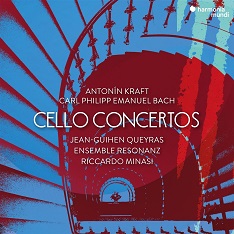Wenn man das Zeitalter der Aufklärung und der Revolution in der zweiten Hälfte des 18. Jahrhunderts festlegt, dann entstanden die beiden zu hörenden Cellokonzerte an dessen Rändern. Dass die Komponisten im Hinblick darauf schrieben, wird man jedoch kaum sagen können.
Bei Carl Philipp Emanuel Bach werden Cellopartie und Orchesterpart miteinander verwoben. Die Solostimme bietet genügend virtuose Betätigungsfelder, aber nicht um ihrer selbst willen. Musikalisch wird das Konzert als Ganzes mit eleganter Leichtigkeit gespannt.
Beim Konzert von Kraft ist noch der Einfluss seines Lehrers Haydn zu spüren. Beibehalten wird die traditionelle klassische Konzertform und eingängige Themen ködern den Zuhörer. Passend für seine eigenen herausragenden Fähigkeiten schrieb Kraft eine sehr anspruchsvolle Solopartie, die mit ungewohnten Konfigurationen aufhorchen lässt.
Dass Jean-Guihen Queyras diesen beiden Kompositionen in der Beherrschung der Materie nicht nur gewachsen ist, sondern sie mit der mitreißenden Eloquenz und Sicherheit darstellt, verwundert nicht. Dabei lässt er sich nicht beirren, was die sangliche Schönheit seines Cellotons angeht; sie bleibt durchgehend gewährleistet. Und ihm bleibt auch genügend Raum, um die ausgefeilte Gestaltung der Soloparts facettenreich, aber nicht kleinteilig, voran zu treiben. Dabei weiß er sich in einem gemeinsamen treibenden Wettstreit mit dem Orchester, die sich insbesondere in den Ecksätzen bei dem Konzert von Kraft gegenseitig animieren.
Das Ensemble Resonanz mit Riccardo Minasi ist bei diesem Zusammenwirken in vielen Teilen auch die animierende und treibende Seite. Dabei scheuen sie auch nicht davor zurück, mitunter einen schroffen rauen Klang zu praktizieren, der einen belebenden Kontrast zum Spiel von Queyras bietet. Hier zeigt sich das Orchester nicht nur als Begleiter, sondern als bedeutsame eigene Stimme, die sich prägnant mitteilen und nicht nur anlehnen will. Dieser Ansatz fördert ein hochintensives Musizieren, bei dem alle Beteiligten mit Elan loslegen.
If the Age of Enlightenment and the Revolution is placed in the second half of the 18th century, then the two cello concertos we are listening to were written on the fringes of this period. Yet, it can hardly be said that the composers wrote with this in mind.
In Carl Philipp Emanuel Bach’s work, the cello part and orchestral part are interwoven. The solo part offers sufficient virtuosic scope, but not for its own sake. Musically, the concerto as a whole is drawn with elegant ease.
The influence of his teacher Haydn can still be felt in Kraft’s concerto. The traditional classical concerto form is retained and catchy themes entice the listener. In keeping with his own outstanding abilities, Kraft wrote a very demanding solo part, which makes you sit up and take notice with its unusual configurations.
It is not surprising that Jean-Guihen Queyras is not only equal to these two compositions in his mastery of the material, but also performs them with rousing eloquence and assurance. At the same time, he does not allow himself to be distracted by the vocal beauty of his cello tone; it remains guaranteed throughout. And he also has enough space to drive forward the sophisticated design of the solo parts in a multifaceted but not small-scale manner. In doing so, he knows he is in a driving competition with the orchestra, which mutually animate each other, especially in the outer movements of Kraft’s concerto.
The Ensemble Resonanz with Riccardo Minasi is also the animating and driving force in many parts of this collaboration. At the same time, they do not shy away from sometimes practicing a rugged, rough sound, which offers an invigorating contrast to Queyras’ playing. Here, the orchestra is not just an accompanist, but a significant voice in its own right, one that wants to communicate concisely and not just lean on. This approach encourages highly intensive music-making, in which everyone involved gets going with verve.


















